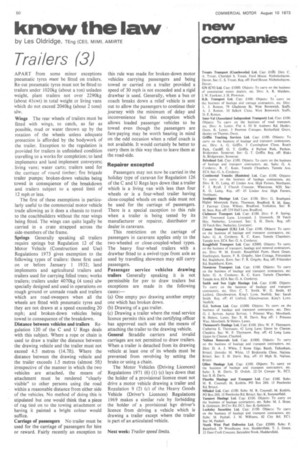know the law
Page 52

If you've noticed an error in this article please click here to report it so we can fix it.
by Les Oldridge, TEng (CEO, MIMI, AMIRTE
Trailers (3)
APART from some minor exceptions pneumatic tyres must be fitted on trailers. Re-cut pneumatic tyres must not be fitted to trailers under 1020kg (about a ton) unladen weight, plant trailers not over 2290kg (about 45cwt) in total weight or living vans which do not exceed 2040kg (about 2 tons) ulw.
Whigs The rear wheels of trailers must be fitted with wings, to catch, as far as possible, mud or water thrown up by the rotation of the wheels unless adequate protection is afforded by the bodywork of the trailer. Exception to the regulation is provided for trailers in unfinished condition travelling to a works for completion; to land implements and land implement conveyors; living vans; water carts; trailers used for the carriage of round timber; fire brigade trailer pumps; broken-down vehicles being towed in consequence of the breakdown and trailers subject to a speed limit of 12 mph or less.
The first of these exemptions is particularly useful to the commercial motor vehicle trade allowing as it does a chassis to travel to the coachbuilders without the rear wings being fitted. The wings can quite legally be carried in a crate strapped across the side-members of the frame.
Springs Generally speaking all trailers require springs but Regulation 12 of the Motor Vehicle (Construction and Use) Regulations 1973 gives exemption to the following types of trailers: those first used on or before January 1 1932; land implements and agricultural trailers and trailers used for carrying felled trees; works trailers; trailers under 4070kg (4 tons) ulw specially designed and used in operations on rough ground or unmade roads and trailers which are road-sweepers when all the wheels are fitted with pneumatic tyres and they are not drawn at a speed exceeding 20 mph; and broken-down vehicles being towed in consequence of the breakdown. Distance between vehicles and trailers Regulation 120 of the C and U Regs deals with this subject. Where a rope or chain is used to draw a trailer the distance between the drawing vehicle and the trailer must not exceed 4.5 metres (14.7ft). Where the distance between the drawing vehicle and the trailer exceeds 1.5 metres (almost 5ft) irrespective of the manner in which the two vehicles are attached, the means of attachment must be rendered "clearly visible" to other persons using the road within a reasonable distance from either side of the vehicles. No method of doing this is stipulated but one would think that a piece of rag tied on to the towing attachment or having it painted a bright colour would suffice.
Carriage of passengers No trailer must be used for the carriage of passengers for hire or reward. Fairly recently an exception to this rule was made for broken-down motor vehicles carrying passengers and being towed or carried on a trailer provided a speed of 30 mph is not exceeded and a rigid drawbar is used. Generally, when a bus or coach breaks down a relief vehicle is sent out to allow the passengers to continue their journey with the minimum of delay and inconvenience but this exception which allows loaded passenger vehicles to be towed even though the passengers are fare-paying may be worth bearing in mind on the odd occasion when a relief coach is not available. It would certainly be better to carry them in this way than to leave them at the road-side.
Repairer excepted Passengers may not now be carried in the holiday type of caravan for Regulation 126 of the C and U kegs lays down that a trailer which is a living van with less than four wheels or is a four-wheel trailer having close-coupled wheels on each side must not be used for the carriage of passengers. There is a special exception to this rule when a trailer is being tested by its manufacturer or repairer, distributor or dealer in caravans.
This restriction on the carriage of passengers in caravans applies only to the two-wheeled or close-coupled-wheel types. The heavy four-wheel trailers with a drawbar fitted to a swivel-type front axle as used by travelling showmen may still carry passengers.
Passenger service vehicles drawing trailers Generally speaking it is not permissible for psv to draw trailers but exceptions are made in the following cases:—
(a) One empty psv drawing another empty one which has broken down.
(b) Drawing of a gas trailer.
(c) Drawing a trailer where the road service licence permits this and the certifying officer has approved such use and the means of attaching the trailer to the drawing vehicle. General Straddle carriers and invalid carriages are not permitted to draw trailers. When a trailer is detached from its drawing vehicle at least one of its wheels must be prevented from revolving by setting the brake or using a chain.
The. Motor Vehicles (Driving Licences) Regulations 1971 (6) (1) (c) lays down that the holder of a provisional licence must not drive a motor vehicle drawing a trailer and Regulation 9 (2) (c) of the Heavy Goods Vehicle (Driver's Licences) Regulations 1969 makes a similar rule by forbidding the holder of a provisional hgv driver's licence from driving a vehicle which is drawing a trailer except where the trailer is part of an articulated vehicle.
Next week: Trailer speed limits.




























































































